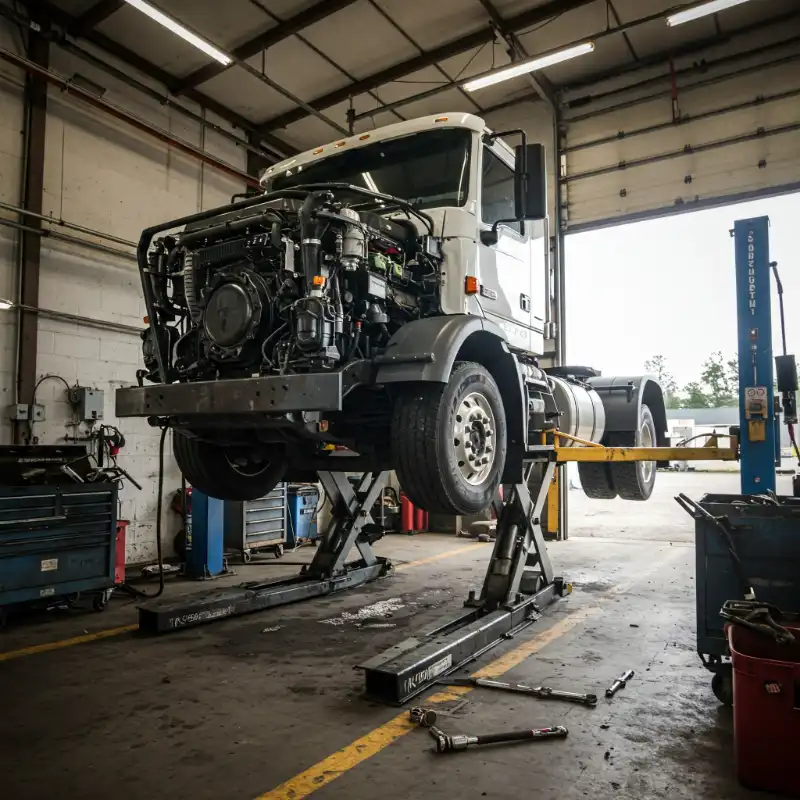Impact of Cold Temperatures on the Cooling System
In freezing temperatures, the coolant within the system can solidify, causing blockages that impede the flow and heat exchange. When the coolant freezes, it expands, leading to potential damage to hoses, radiators, and other components. This can result in costly repairs and downtime for truck operators.
To counteract these challenges, it is crucial to understand the unique demands of winter conditions on heavy-duty trucks and take proactive measures to protect the cooling system.
Choosing the Right Coolant
Selecting the appropriate coolant for winter conditions is a fundamental step in ensuring the reliability of your heavy-duty truck's cooling system. Different types of coolant are available in the market, each with its specific properties and antifreeze capabilities.
Types of Coolant and Antifreeze Properties
Antifreeze is pivotal in preventing the coolant from freezing in cold temperatures. Common types include ethylene glycol and propylene glycol, each offering distinct advantages. Ethylene glycol is widely used and provides excellent heat transfer properties, while propylene glycol is known for its environmentally friendly and non-toxic characteristics.
Understanding the composition of these coolants enables fleet managers and truck owners to make informed decisions based on the specific needs of their vehicles and the prevailing winter conditions.
Ideal Coolant Mixture for Optimal Performance
Maintaining the correct coolant-to-water ratio is crucial for ensuring optimal performance in cold weather. A well-balanced mixture enhances the coolant's ability to withstand freezing temperatures while efficiently transferring heat. Fleet managers should consult the vehicle manufacturer's recommendations and adjust the coolant mixture accordingly.
Inspecting and Maintaining Radiators and Hoses
The radiator and hoses are critical components of the cooling system, and their proper maintenance is essential to prevent issues during winter. Regular inspections help identify wear and tear, ensuring that the system functions seamlessly when temperatures plummet.
Inspecting Radiators and Hoses for Wear and Tear
Perform a thorough visual inspection of radiators and hoses, checking for any signs of cracks, leaks, or corrosion. Ensure that hose connections are secure and that there is no visible damage to the radiator fins. Replace any damaged components promptly to prevent coolant leakage and subsequent overheating.
Significance of a Clean Radiator for Cooling Efficiency
A clean radiator is essential for efficient heat exchange. Winter conditions often lead to the accumulation of snow, ice, and road salt on the radiator surface, reducing its effectiveness. Regularly clean the radiator to remove these obstructions, allowing unrestricted airflow and maintaining optimal engine temperature.
Flushing the System and Checking for Leaks
Routine maintenance, such as flushing the cooling system, helps remove debris and contaminants that may hinder performance. Additionally, check for leaks in hoses, connections, and the radiator itself. Addressing these issues proactively prevents coolant loss and minimizes the risk of engine overheating.
Ensuring Proper Thermostat Functionality
The thermostat plays a crucial role in regulating the engine temperature by controlling the flow of coolant. In winter conditions, a malfunctioning thermostat can lead to inadequate heating and potential engine damage.
Role of the Thermostat
The thermostat acts as a valve that opens and closes based on the engine temperature. In colder weather, it remains closed to allow the engine to warm up quickly. Once the optimal temperature is reached, the thermostat opens, enabling the coolant to circulate and dissipate heat.
Potential Issues with the Thermostat in Winter and How to Address Them
Common issues with thermostats in winter include sticking, where the valve fails to open or close properly. This can result in either prolonged engine warm-up times or overheating. Testing the thermostat before the onset of winter and replacing it if necessary ensures that the cooling system operates efficiently throughout the colder months.
Conduct a thermostat test by observing the engine temperature gauge. If the temperature rises too slowly or consistently exceeds the normal range, the thermostat may be faulty. In such cases, replace the thermostat with a high-quality, winter-appropriate component to maintain precise control over the engine temperature.
Winterizing the Cooling System
Winterizing the entire cooling system involves a comprehensive set of steps to safeguard against the challenges posed by cold weather. In addition to choosing the right coolant and maintaining key components, consider additional measures to enhance winter performance.
Steps to Winterize the Cooling System
Flush and Refill:
- Begin by flushing the entire cooling system to remove old coolant and debris.
- Refill the system with the recommended winter-grade coolant, ensuring the correct mixture ratio.
Install a Winter Front or Grille Cover:
- Adding a winter front or grille cover helps maintain optimal engine temperature by reducing the amount of cold air flowing through the radiator.
- Ensure that the cover is properly fitted and allows for sufficient airflow to prevent overheating.
Check and Tighten Belts:
- Cold weather can cause belts to contract, leading to slippage and decreased efficiency.
- Inspect belts for wear and tightness, adjusting or replacing them as needed.
Inspect and Charge the Battery:
- Cold temperatures can strain the battery, reducing its efficiency.
- Check the battery's condition, terminals, and charge level, ensuring it is prepared for winter demands.
Verify the Operation of the Block Heater:
- For trucks equipped with block heaters, ensure they are functioning correctly.
- Block heaters aid in preheating the engine, reducing strain during startup in extremely cold conditions.
Preventive Maintenance
Preventive maintenance is the key to a trouble-free winter for heavy-duty trucks. Regularly scheduled inspections, timely repairs, and adherence to manufacturer guidelines contribute to the longevity and reliability of the cooling system. Addressing issues proactively avoids costly repairs and downtime during critical transportation periods.
Conclusion
Preparing your heavy-duty truck's cooling system for winter conditions is a multifaceted task that requires attention to detail and proactive measures. Understanding the specific challenges of cold weather, choosing the right coolant, inspecting and maintaining radiators and hoses, ensuring proper thermostat functionality, and comprehensive winterization are all integral components of a successful winter preparedness plan.
To learn more about our coolant system repairs and services, click here!










.webp)





























